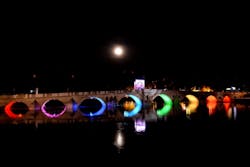Philips LED fixtures reveal architecture of Turkey's Tunca Bridge
The heritage city of Edirne can now celebrate and fully enjoy the historical Tunca Bridge with connected tunable LED fixtures fully revealing the architectural details of the arches and central tower.
Philips Lighting has announced another LED lighting project at an iconic historical site — the Tunca Bridge constructed during the Ottoman Empire that links Edirne, Turkey with western neighborhoods of the city and ultimately Greece. Solid-state lighting (SSL) products, including color-tunable LED fixtures from Philips Color Kinetics, combine with a network control system to present a dynamic nighttime experience that fully reveals the historic architectural details of the bridge.
Interested in more articles & announcements on architectural lighting?
Philips has been involved with a number of bridge projects including the Big Four Bridge in Louisville, KY. But the Tunca project required great care to ensure that no damage was done to the bridge structure. Indeed, the company said that it had to devise ways to mount the LED fixtures without drilling into the bridge structure. Instead, the team working on the bridge used steel cables and plates to add luminaire mounting locations at select points on the structure.
The completed project uses Color Kinetics iColor Graze MX Powercore linear grazing luminaires, Color Blast Powercore wall washers, and water-resistant C-Splash LED fixtures to deliver the dynamic or subtle lighting of the arches. The project also used Philips ProFlood 150W projectors and ilti Luce Lux20 spotlights from a Philips business unit in Italy.
Previously, simple projectors only lit the silhouette of the bridge. The new system fully reveals the arches and facades of the structure. Moreover, the design also includes inner and outer lighting of the dome of the Kitabe Pavilion in the center of the bridge. Color or shades of white can be applied to both the arches and the central tower.
Despite the far superior lighting experience afforded by the new SSL installation, the project will deliver significant energy savings of 53% relative to the simpler projector-only systems used previously. Moreover, a combined wired and wireless control system allows for both the dynamic presentation and dimming of the lighting for additional savings.
Philips worked directly with the Governor's Office of Edirne on the project. "The preservation of historical monuments that are cultural assets should not be seen as the responsibility of conservation specialists alone," said Özge Süzen, marketing director for Philips Lighting in Turkey. "At Philips we believe that we can add a far wider dimension to the concept of preservation by infusing life into monuments with light and drawing on the contribution of townspeople. We would like to thank the Office of the Governor of Edirne for their support in managing the process and their appreciation of the role of light to help preserve and enhance our cultural heritage."
Indeed, historic sites present special challenges to lighting designers and specifiers. LED-based products with lower power requirements, better beam control, and greater lumen output have been vital in many such projects. For example, we have previously covered the lighting of the Recouvrance lift bridge in Brest, France. Recently, we wrote about the new LED lighting of the historic Citadel of Bonifacio on Corsica.

Maury Wright | Editor in Chief
Maury Wright is an electronics engineer turned technology journalist, who has focused specifically on the LED & Lighting industry for the past decade. Wright first wrote for LEDs Magazine as a contractor in 2010, and took over as Editor-in-Chief in 2012. He has broad experience in technology areas ranging from microprocessors to digital media to wireless networks that he gained over 30 years in the trade press. Wright has experience running global editorial operations, such as during his tenure as worldwide editorial director of EDN Magazine, and has been instrumental in launching publication websites going back to the earliest days of the Internet. Wright has won numerous industry awards, including multiple ASBPE national awards for B2B journalism excellence, and has received finalist recognition for LEDs Magazine in the FOLIO Eddie Awards. He received a BS in electrical engineering from Auburn University.





